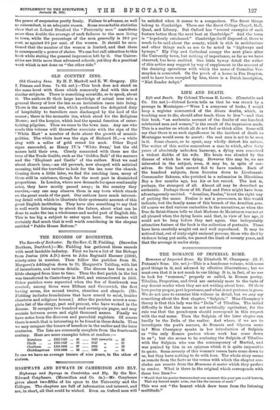OLD COUNTRY DINS.
Old Country Inns. By H. P. Maskell and E. W. Gregory. (Sir I. Pitanan and Sons. 7s. 6d. net.)—This book does not stand on the same level with those which commonly deal with this and similar subjects. There is something scientific, so to speak, about it. The authors fit their large knowledge of actual inns into a general theory of how the inn as an institution came into being. There is the manorial inn, which performed the delegated duty of hospitality to travellers once discharged by the lord of the manor; there is the monastic inn, which stood for the Religious House; and the hospice, which had the special function of enter- taining pilgrims. Then we come to the town inns. Any one who reads this volume will thereafter associate with the sign of the 'White Hart' a number of facts about the growth of munici- palities. The white hart was the sign of Richard IL,—a white stag with a collar of gold round his neck. Other Royal signs =weeded, as Henry IV.'s White Swan,' but the old names held their own. Closely connected with these are the inns of the Trade Guilds, such as the Golden Ball' of the mercers and the 'Elephant and Castle' of the cutlers. Next we read about church inns,—an old proverb, now charged with satirical meaning, told the traveller to look for the inn near the church. Coming down a little later, we find the coaching inns, many of them still in existence, though for the most part in diminished proportions. In London, where new demands for space continually arise, they have mostly passed away; in the country they survive,—any one may observe them in any town which stands on the great roads of the past. Our authors have much interest- ing detail with which to illustrate their systematic account of this great English institution. They have also something to say that is well worth listening to about the future, about what can be done to make the inn a wholesome and useful part of English life. This is too big a subject to enter upon here. Our readers will certainly find much that is well worth considering in the chapter entitled "Public House Reform."






















































 Previous page
Previous page